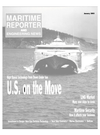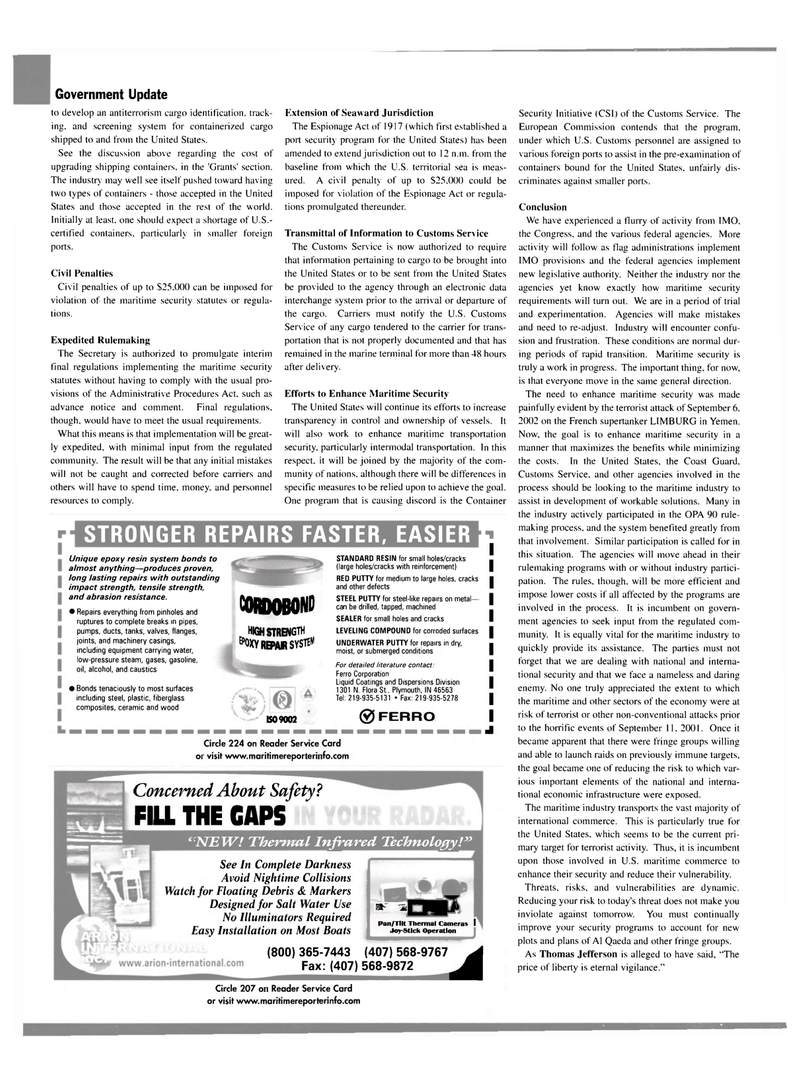
Page 22: of Maritime Reporter Magazine (January 2003)
Read this page in Pdf, Flash or Html5 edition of January 2003 Maritime Reporter Magazine
Government Update to develop an antiterrorism cargo identification, track- ing. and screening system for containerized cargo shipped to and from the United States.
See the discussion above regarding the cost of upgrading shipping containers, in the 'Grants' section.
The industry may well see itself pushed toward having two types of containers - those accepted in the United
States and those accepted in the rest of the world.
Initially at least, one should expect a shortage of Un- certified containers, particularly in smaller foreign ports.
Civil Penalties
Civil penalties of up to $25,000 can be imposed for violation of the maritime security statutes or regula- tions.
Expedited Rulemaking
The Secretary is authorized to promulgate interim final regulations implementing the maritime security statutes without having to comply with the usual pro- visions of the Administrative Procedures Act. such as advance notice and comment. Final regulations, though, would have to meet the usual requirements.
What this means is that implementation will be great- ly expedited, with minimal input from the regulated community. The result will be that any initial mistakes will not be caught and corrected before carriers and others will have to spend time, money, and personnel resources to comply.
Extension of Seaward Jurisdiction
The Espionage Act of 1917 (which first established a port security program for the United States) has been amended to extend jurisdiction out to 12 n.m. from the baseline from which the U.S. territorial sea is meas- ured. A civil penalty of up to $25,000 could be imposed for violation of the Espionage Act or regula- tions promulgated thereunder.
Transmittal of Information to Customs Service
The Customs Service is now authorized to require that information pertaining to cargo to be brought into the United States or to be sent from the United States be provided to the agency through an electronic data interchange system prior to the arrival or departure of the cargo. Carriers must notify the U.S. Customs
Service of any cargo tendered to the carrier for trans- portation that is not properly documented and that has remained in the marine terminal for more than 48 hours after delivery.
Efforts to Enhance Maritime Security
The United States will continue its efforts to increase transparency in control and ownership of vessels. It will also work to enhance maritime transportation security, particularly intermodal transportation. In this respect, it will be joined by the majority of the com- munity of nations, although there will be differences in specific measures to be relied upon to achieve the goal.
One program that is causing discord is the Container
Security Initiative (CSI) of the Customs Service. The
European Commission contends that the program, under which U.S. Customs personnel are assigned to various foreign ports to assist in the pre-examination of containers bound for the United States, unfairly dis- criminates against smaller ports.
Conclusion
We have experienced a flurry of activity from IMO. the Congress, and the various federal agencies. More activity will follow as flag administrations implement
IMO provisions and the federal agencies implement new legislative authority. Neither the industry nor the agencies yet know exactly how maritime security requirements will turn out. We are in a period of trial and experimentation. Agencies will make mistakes and need to re-adjust. Industry will encounter confu- sion and frustration. These conditions are normal dur- ing periods of rapid transition. Maritime security is truly a work in progress. The important thing, for now, is that everyone move in the same general direction.
The need to enhance maritime security was made painfully evident by the terrorist attack of September 6, 2002 on the French supertanker LIMBURG in Yemen.
Now, the goal is to enhance maritime security in a manner that maximizes the benefits while minimizing the costs. In the United States, the Coast Guard,
Customs Service, and other agencies involved in the process should be looking to the maritime industry to assist in development of workable solutions. Many in the industry actively participated in the OPA 90 rule- making process, and the system benefited greatly from that involvement. Similar participation is called for in this situation. The agencies will move ahead in their rulemaking programs with or without industry partici- pation. The rules, though, will be more efficient and impose lower costs if all affected by the programs are involved in the process. It is incumbent on govern- ment agencies to seek input from the regulated com- munity. It is equally vital for the maritime industry to quickly provide its assistance. The parties must not forget that we are dealing with national and interna- tional security and that we face a nameless and daring enemy. No one truly appreciated the extent to which the maritime and other sectors of the economy were at risk of terrorist or other non-conventional attacks prior to the horrific events of September 11, 2001. Once it became apparent that there were fringe groups willing and able to launch raids on previously immune targets, the goal became one of reducing the risk to which var- ious important elements of the national and interna- tional economic infrastructure were exposed.
The maritime industry transports the vast majority of international commerce. This is particularly true for the United States, which seems to be the current pri- mary target for terrorist activity. Thus, it is incumbent upon those involved in U.S. maritime commerce to enhance their security and reduce their vulnerability.
Threats, risks, and vulnerabilities are dynamic.
Reducing your risk to today's threat does not make you inviolate against tomorrow. You must continually improve your security programs to account for new plots and plans of Al Qaeda and other fringe groups.
As Thomas Jefferson is alleged to have said, "The price of liberty is eternal vigilance."
STRONGER REPAIRS FASTER, EASIER
Unique epoxy resin system bonds to almost anything—produces proven, long lasting repairs with outstanding impact strength, tensile strength, and abrasion resistance. • Repairs everything from pinholes and ruptures to complete breaks in pipes, pumps, ducts, tanks, valves, flanges, joints, and machinery casings, including equipment carrying water, low-pressure steam, gases, gasoline, oil, alcohol, and caustics • Bonds tenaciously to most surfaces including steel, plastic, fiberglass composites, ceramic and wood
CORDOBOND
HIGH STRENGTH
Ep0XY REPAIR SYSTtV
STANDARD RESIN for small holes/cracks (large holes/cracks with reinforcement)
RED PUTTY for medium to large holes, cracks and other defects
STEEL PUTTY for steel-like repairs on metal— can be drilled, tapped, machined
SEALER for small holes and cracks
LEVELING COMPOUND for corroded surfaces
UNDERWATER PUTTY for repairs in dry, moist, or submerged conditions
For detailed literature contact:
Ferro Corporation
Liquid Coatings and Dispersions Division 1301 N. Flora St., Plymouth, IN 46563
Tel: 219-935-5131 • Fax: 219-935-5278
ISO 9002 ® FERRO
I
I
I
I
I
I
I
I
I
I
I
J
Circle 224 on Reader Service Card or visit www.maritimereporterinfo.com
Concerned About Safety?
PILL THE CAPS :NE W! Thermal Infrared Technology!"
See lit Complete Darkness
Avoid Nightime Collisions
Watch for Floating Debris & Markers
Designed for Salt Water Use
No Illuminators Required
Easy Installation on Most Boats • -M •gT
I Pan/Tilt Thermal Cameras 1
Joy-Stick Operation (800) 365-7443 (407) 568-9767
Fax: (407) 568-9872 A
Circle 207 on Reader Service Card or visit www.maritimereporterinfo.com

 21
21

 23
23
